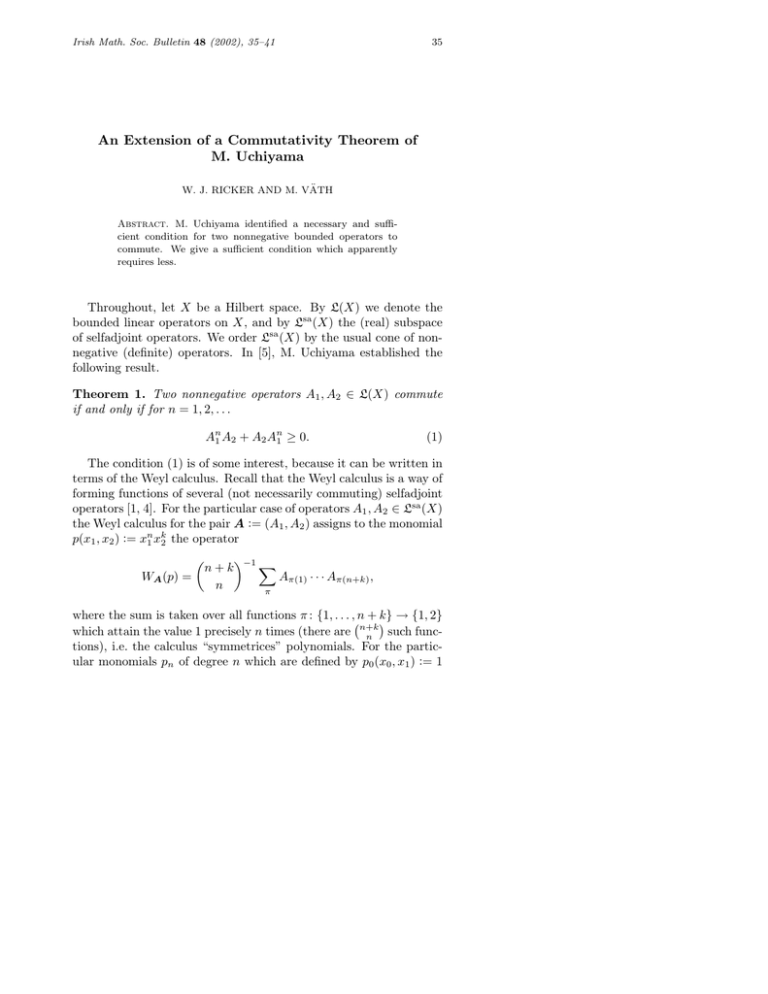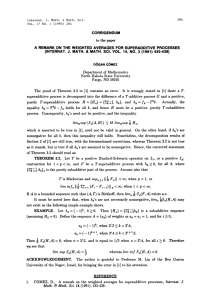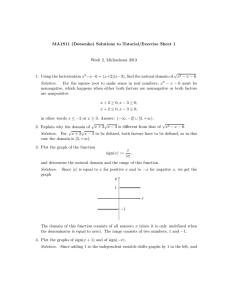An Extension of a Commutativity Theorem of M. Uchiyama
advertisement

Irish Math. Soc. Bulletin 48 (2002), 35–41
35
An Extension of a Commutativity Theorem of
M. Uchiyama
W. J. RICKER AND M. VÄTH
Abstract. M. Uchiyama identified a necessary and sufficient condition for two nonnegative bounded operators to
commute. We give a sufficient condition which apparently
requires less.
Throughout, let X be a Hilbert space. By L(X) we denote the
bounded linear operators on X, and by Lsa (X) the (real) subspace
of selfadjoint operators. We order Lsa (X) by the usual cone of nonnegative (definite) operators. In [5], M. Uchiyama established the
following result.
Theorem 1. Two nonnegative operators A1 , A2 ∈ L(X) commute
if and only if for n = 1, 2, . . .
An1 A2 + A2 An1 ≥ 0.
(1)
The condition (1) is of some interest, because it can be written in
terms of the Weyl calculus. Recall that the Weyl calculus is a way of
forming functions of several (not necessarily commuting) selfadjoint
operators [1, 4]. For the particular case of operators A1 , A2 ∈ Lsa (X)
the Weyl calculus for the pair A := (A1 , A2 ) assigns to the monomial
p(x1 , x2 ) := xn1 xk2 the operator
WA (p) =
µ
¶−1 X
n+k
Aπ(1) · · · Aπ(n+k) ,
n
π
where the sum is taken over all functions π : {1, . . . ,¡n + ¢k} → {1, 2}
which attain the value 1 precisely n times (there are n+k
such funcn
tions), i.e. the calculus “symmetrices” polynomials. For the particular monomials pn of degree n which are defined by p0 (x0 , x1 ) := 1
W. J. Ricker and M. Väth
36
and pn (x1 , x2 ) := xn−1
x2 , the above formula becomes
1
WA (pn ) =
n−1
1X k
A1 A2 An−1−k
,
1
n
k=0
from which it follows that
(n + 1)WA (pn+1 ) − (n − 1)A1 WA (pn−1 )A1 = An1 A2 + A2 An1
or, similarly, that
2(n + 1)WA (pn+1 ) − nA1 WA (pn ) − nWA (pn )A1 = An1 A2 + A2 An1 .
These identities express the left-hand-side of (1) in terms of WA (pn )
and A1 . Note that the operators WA (pn ) are all selfadjoint (this
follows from the above formulae and is also a general property of the
Weyl calculus of a real function [1]).
In a similar manner, one can write down other recursion formulae
for WA (pn ) which, by insertion into the above formulae, give many
other expressions for An1 A2 + A2 An1 in terms of WA (pn ) and A1 .
A typical sample of a commutativity result in terms of the Weyl
calculus (using the above formulae and Theorem 1) is as follows.
Corollary 1. Let A1 , A2 ∈ L(X) be nonnegative. Then A1 A2 =
A2 A1 if and only if
WA (pn+1 ) ≥
n−1
A1 WA (pn−1 )A1 ,
n+1
(n = 1, 2, . . . ).
The main interest of (1) is that it implies A1 A2 = A2 A1 . We
intend to prove commutativity in the situation that one does not
know (1) a priori in full strength or perhaps not for all indices n. Of
course, as a conclusion one then obtains that (1) actually holds for
all n = 1, 2, . . . . Let us first give an example which shows, even if
X is finite dimensional, that it is not sufficient to verify (1) for any
fixed finite family of indices n.
Example 1. Consider X := C2 and the noncommuting nonnegative
21
matrices A1 := ( 0c 10 ) (1 6=
³ c ≥ 0) and
´ A2 := ( 1 1 ). Since the (1, 1)entry of An1 A2 +A2 An1 =
4cn cn +1
cn +1 2
is nonnegative for every n, this
matrix is nonnegative if and only if its determinant −(cn )2 +6cn −1 is
nonnegative. Clearly, for any N , there exists c 6= 1 but “close to 1”
such that An1 A2 + A2 An1 ≥ 0 for n = 1, . . . , N , although A1 A2 6=
A2 A1 .
An Extension of a Commutativity Theorem of M. Uchiyama
37
Example 1 demonstrates impressively that Theorem 1 above is an
“asymptotic” result: The “closer” the operators are to commuting
(i.e. the closer c is to 1), the larger n must be chosen so that An1 A2 +
A2 An1 6≥ 0.
To obtain the announced generalization of Theorem 1, we need the
associativity of the standard calculus for bounded normal operators.
This property is probably known; since we could not find a reference,
a short proof is included.
Proposition 1. Let A ∈ L(X) be normal and σ(A) denote the spectrum of A. If f : σ(A) → C and g : σ(f (A)) → C are bounded Borel
functions, then the standard calculus for normal operators satisfies
g(f (A)) = (g ◦ f )(A).
(2)
Before we turn to the proof, a comment on the right-hand-side
of (2) is in order. Since only σ(f (A)) ⊆ f (σ(A)) (see e.g. [2, Section X.2, Corollary 9]), it is not the case, in general, that g ◦ f is
defined on σ(A). However, the set where it is not defined is only a
null set with respect to the resolution of identity of A, i.e. the righthand-side of (2) is well-defined by extending g to an arbitrary Borel
function on a Borel set containing f (σ(A)), if necessary.
RProof. Let P denote the resolution of the identity of A. Then f (A) =
f dP and supp(P ) = σ(A); to see this let f be the identity
σ(A)
function on σ(A) in [2, Section X.2, Corollary 9(iii)]. The resolution of the identity Pf of f (A) is given by Pf (B) := P (f −1 (B)),
see e.g. [2, Section X.2, Corollary 10]. Analogously, the resolution of
the identity of g(f (A)) is then given by (Pf )g , where (Pf )g (B) :=
P (f −1 (g −1 (B))) = P ((g ◦ f )−1 (B)) =: Pg◦f (B). The same result
holds, of course, for any extension of g to a bounded Borel function
on a Borel set containing f (σ(A)). Applying [2, Section X.2, Corollary 10] to ge◦f , where ge denotes another such extension, we find that
the resolution of the identity ofR ge◦f is given by Pge◦f = (Pf )ge = (Pf )g
(in particular, (e
g ◦ f )(A) = σ(A) id d(Pf )g = g(f (A))). Accordingly, ge(f (A)) is independent of the choice of the extension ge, and
so ge ◦ f = g ◦ f except possibly on a P -null set and thus, (g ◦ f )(A)
is defined and equal to (e
g ◦ f )(A) = g(f (A)).
¤
If we combine Proposition 1 with the fact that the inverse of any
Borel function is automatically a Borel function (because it maps
Borel sets onto Borel sets [3, §39, V, Theorem 1]), we obtain:
38
W. J. Ricker and M. Väth
Proposition 2. Let A ∈ L(X) be normal. If f : σ(A) → C is
an injective, bounded Borel function, then an operator B ∈ L(X)
commutes with A if and only if it commutes with f (A).
Proof. Let f −1 denote a left-inverse (extended to a Borel function
on f (σ(A))). Recall that any bounded operator that commutes with
A also commutes with f (A), because it commutes with each spectral
projection. Hence, if B ∈ L(X) commutes with f (A), then it also
commutes, in view of Proposition 1, with g(f (A)) = (g ◦ f )(A) =
id (A) = A.
¤
By a fractional power Aα of a nonnegative operator A ∈ L(X),
we mean the operator f (A) with f (x) = xα (α > 0) in the sense of
the standard calculus. Note that this is the “right” definition for the
power, since Proposition 1 implies (Aα )β = Aα+β .
Corollary 2. Let A1 , A2 ∈ L(X) be nonnegative. Then A1 A2 =
β
β α
A2 A1 if and only if Aα
1 A2 = A2 A1 for some, and thus all, (not
necessarily integer) powers α, β > 0.
For an operator A ∈ Lsa (X), it will be convenient to use the
notation
min A := min σ(A) = inf hAx, xi .
kxk=1
We are now in a position to formulate the main result.
Theorem 2. Two nonnegative operators A1 , A2 ∈ L(X) commute
if and only if there are constants ε > 0, j ∈ N, ` > 0, and c, d ≥ 0
such that, for all n = j, 2j, 3j, . . . we have
µ ¶
n
X
¡ `·k
¢ n k n−k
n
`·k
`·k
(d+2 min A2 )c +
min A1 A2 +A2 A1 + dA1
ε c
≥ 0.
k
k=1
(3)
In this case, each summand in (3) is actually nonnegative for each
choice of the constants j ∈ N, ` > 0, and c, d ≥ 0.
α
Proof. If A1 A2 = A2 A1 , then min(Aα
1 A2 +A2 A1 ) ≥ 0 for any α > 0,
and so (3) follows for any choice of the constants. Conversely, assume
that (3) holds. Put B1 := εA`1 + cI and B2 := A2 + d2 I. Then,
An Extension of a Commutativity Theorem of M. Uchiyama
39
(B1j )n B2 + B2 (B1j )n = B1jn B2 + B2 B1jn
¶
jn µ
X
¢ k jn−k
jn ¡ `·k
`·k
=
A1 A2 + A2 A`·k
ε c
1 + dA1
k
k=0
≥ (dI + 2A2 )cjn
¶
jn µ
X
¡
¢ k jn−k
jn
`·k
`·k
+
min A`·k
Iε c
1 A2 + A2 A1 + dA1
k
k=1
≥0
for all n.
Theorem 1 then implies B1j B2 = B2 B1j which, in view of Corollary 2, is equivalent to B1 B2 = B2 B1 and thus to A`1 A2 = A2 A`1 or
to A1 A2 = A2 A1 .
¤
Corollary 3. Let A1 , A2 ∈ L(X) be nonnegative. Then A1 A2 =
A2 A1 if and only if there exist N ∈ N and d ≥ 0 such that the
selfadjoint operators
An1 A2 +A2 An1 +dAn1 = (n+1)WA (pn+1 )−(n−1)A1 WA (pn−1 )A1 +dAn1 ,
for n = N, 2N, 3N, . . . , are nonnegative. In particular, A1 A2 =
A2 A1 if (1) holds for all except possibly finitely many numbers n.
Proof. Apply Theorem 2 with ` = N .
¤
Note, for kA1 k ≤ 1 (which one can arrange by appropriate scalα
α
ing), that the numbers min (Aα
1 A2 + A2 A1 + dA1 ) which occur in (3)
always have a lower bound which is independent of α. However, it
appears that by applying only this fact and straightforward estimates
to (3), one cannot generalize Corollary 3 to the situation when one
does not have a priori information about these numbers in some
infinite arithmetic sequence of α’s. However, in finite dimensional
spaces one can use a different argument to obtain commutativity.
Theorem 3. Let X be finite dimensional, and let A1 , A2 ∈ L(X) be
nonnegative. Then A1 A2 = A2 A1 if and only if there is some d ≥ 0
and an unbounded subset S ⊆ [0, ∞) such that
α
α
Aα
1 A2 + A2 A1 + dA1 ≥ 0
(α ∈ S).
In this case, (4) actually holds for S = [0, ∞) and each d ≥ 0.
(4)
40
W. J. Ricker and M. Väth
Proof. By considering an appropriate basis in X, we may assume
that A1 is represented by a diagonal matrix. Then the entries of
α
α
the matrix M (α) := Aα
1 A2 + A2 A1 + dA1 are sums of terms of the
α
form c d where c > 0 and d ∈ R are independent of α. Recall that
M (α) ≥ 0 if and only if all the minors of M (α) are nonnegative.
But, the minors of M (α) are sums (or differences) of products of
entries of the matrix M (α), i.e., they have the form (after elementary
PK
α
manipulations)
k=1 ck dk with 0 < d1 < · · · < dK and ck 6= 0
independent of α. If dK ≥ 1, then the sign of this expression is the
sign of cK for all sufficiently large α. If dK < 1, then the sign of this
expression attains the sign of c1 for all sufficiently large α. In all
cases, the minors of M (α) do not change their sign for sufficiently
large α, i.e. M (αn ) ≥ 0 for some sequence αn → ∞ if and only if
M (α) ≥ 0 for all sufficiently large α. Hence, the statement follows
from Theorem 2.
¤
We do not know whether Theorem 3 also holds in general Hilbert
spaces X. At least, there cannot be a counterexample which consists
of an (infinite) diagonal matrix A1 and a “block matrix” A2 .
Corollary 4. Let A1 , A2 ∈ L(X) be nonnegative. Assume that there
is some finite dimensional subspace U ⊆ X which is invariant under
A1 and A2 and such that the restrictions satisfy A1 A2 |U 6= A2 A1 |U .
Then, for any d ≥ 0 and any unbounded S ⊆ [0, ∞), the relation (4)
fails.
Proof. For each sufficiently large α > 0, the restriction of Bα :=
α
α
Aα
1 A2 + A2 A1 + dA1 to U fails to be nonnegative by Theorem 3. So,
the extension Bα cannot be nonnegative either.
¤
References
[1] Anderson, R. F. V., The Weyl functional calculus, J. Funct. Anal. 4 (1969),
240–267.
[2] Dunford, N. and Schwartz, J. T., Linear operators II, Wiley-Interscience,
New York, London, 1963.
[3] Kuratowski, K., Topology, vol. I, Academic Press, New York, San Franisco,
London, 1966.
[4] Taylor, M. E., Functions of several self-adjoint operators, Proc. Amer. Math.
Soc. 19 (1968), 91–98.
[5] Uchiyama, M., Commutativity of selfadjoint operators, Pacific J. Math. 161
(1993), no. 2, 385–392.
An Extension of a Commutativity Theorem of M. Uchiyama
Werner J. Ricker, M. Väth,
Math.-Geogr. Fakultät,
Katholische Universität Eichstätt,
D-85071 Eichstätt, Germany
werner.ricker@ku-eichstaett.de
vaeth@mathematik.uni-wuerzburg.de
Received on 23 April 2002.
41




